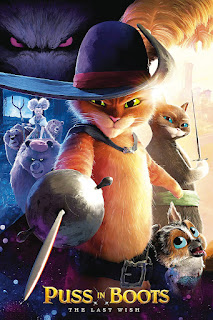Puss In Boots: The Last Wish - Spectacular Enhancement
Thoughts On: Puss In Boots (2022)
Puss reaches the last of his 9 lives, pulled violently onto an existential journey to escape death.
Puss in Boots: The Last Wish is a magnificent display of the possibilities in animation. The style of this film and the ingenious injections of spectacular cinematics filled me with joy, so happy to see animation used to push the limits of the narratives and kinds of action we get to see on screen. I can't praise the style of this film more. Its tone is ok - the humour doesn't always hit for me - but the narrative is pleasant.
The Last Wish indicates that wishes are for the ignorant and stupid; they both pull the wishful fool, and release them onto themselves. The bad of heart, or even troubled of heart, are shown to only have trouble to find in wishes. The good of heart have no use for them though the easiest access. In the end, the path to a wish is the one of least resistance; a wish comes easy, so let it. Wish for the impossible, and the impossible will happen to you. Seek what is easy and true, and you will already have it.
Of interest as it regards film theory in The Last Wish is its exemplification of a narrative without an abundance of themes with deep roots to follow. The film remains straight in its themes and evocations, not striving for anything too essential, complex or simple - just rather straight. And in this, it demonstrates good balance between logos and pneuma; style and meaning-making. This is a film of spectacle, whose beauty is in its construction and aesthetics more so than its narrative powers and evocation of themes. The aesthetics and style of The Last Wish elevates the simple narrative to something grand and spectacular; quite like the very characters they utilise. Each character, either in their archetype, or specific character construction is a meaningful entity: they are a fairy-tale creatures with narratives external to the present one. These external narratives hold themes that are imbued into the characters, making them a symbol of sorts, that then self-reflect in the dramaturgy. Puss In Boots thus has a breakdown having come to the last of his 9 lives; he reflects on the narratives of his life quite literally, on each of the 8 other selves he built.
The engagement Puss, along with all of the other characters - Goldilocks and the 3 bears; Jack Horner - have with their narratives is simple. Goldilocks manifests as the selfish and spoilt child she appears to be in the original tale in which she breaks into and robs food from three bears; Jock Horner as a minor figure in a poem about a baby who gets to eat all his pie, thus becoming a symbol of greed, manifests as the Thanos of the Skrek universe, wanting to collect every magical power for himself. Puss arrives on screen a fool who has lived without fear of death simply because he convinced himself he was invincible; this lead him to lead grand but empty lives. These reflections are quite silly and comedic, but they are enhanced by the spectacle of the film - especially in the fight and action sequences. We then see Puss himself realise that he truly shouldn't fear death, and in such, live meaningfully with knowledge of his demise through the vast expressionism of the fight scenes. This notions maps onto other characters through the wishes. The failure to step into the archetypal 'room' (maybe most iconic in Tarkovsky's Stalker) to meet their wishes is what enlightens each character to the resolution of their epic struggles through the adventures of this film.
One to be seen more than talked about in many ways, Puss in Boots was a wonderful vibe with blistering action sequences that supersize and magnify the basic themes of this narrative with musical flair. A melodrama to be remembered.










